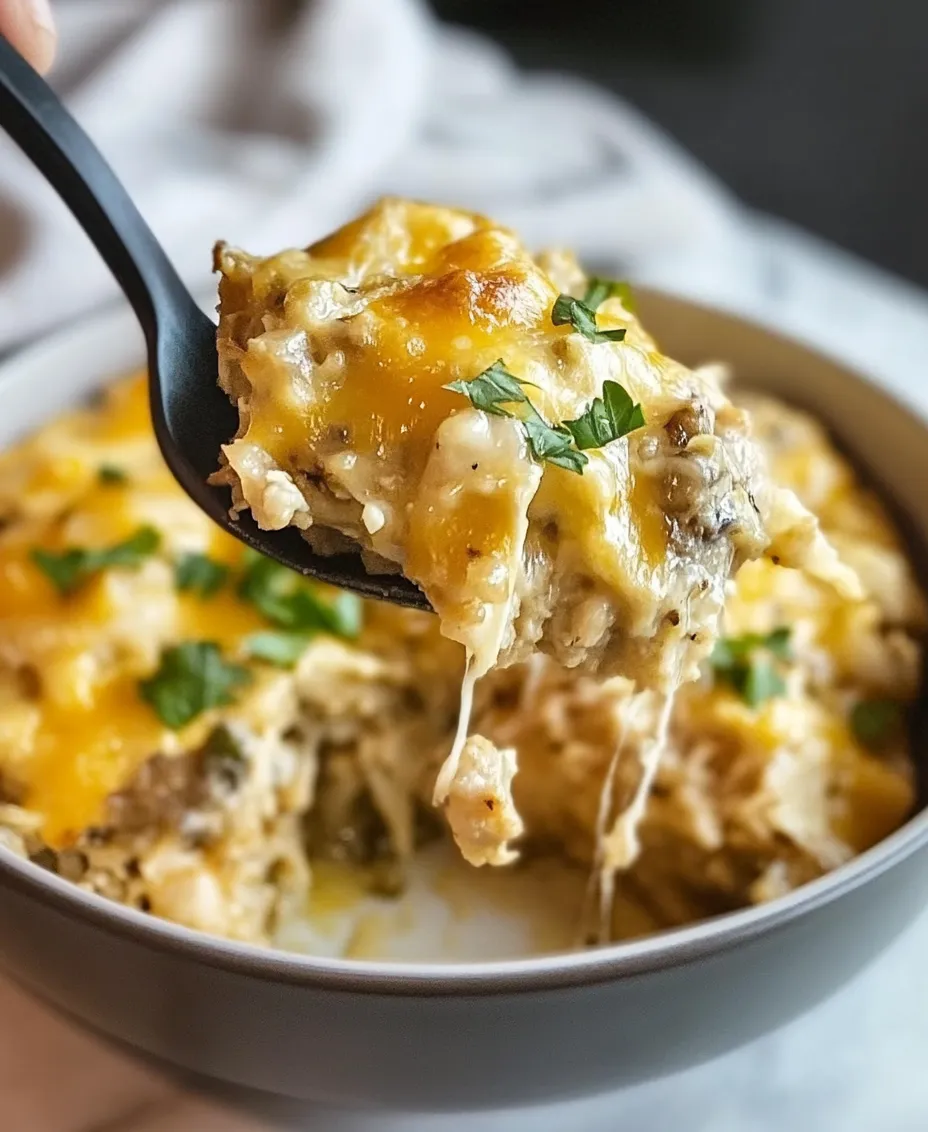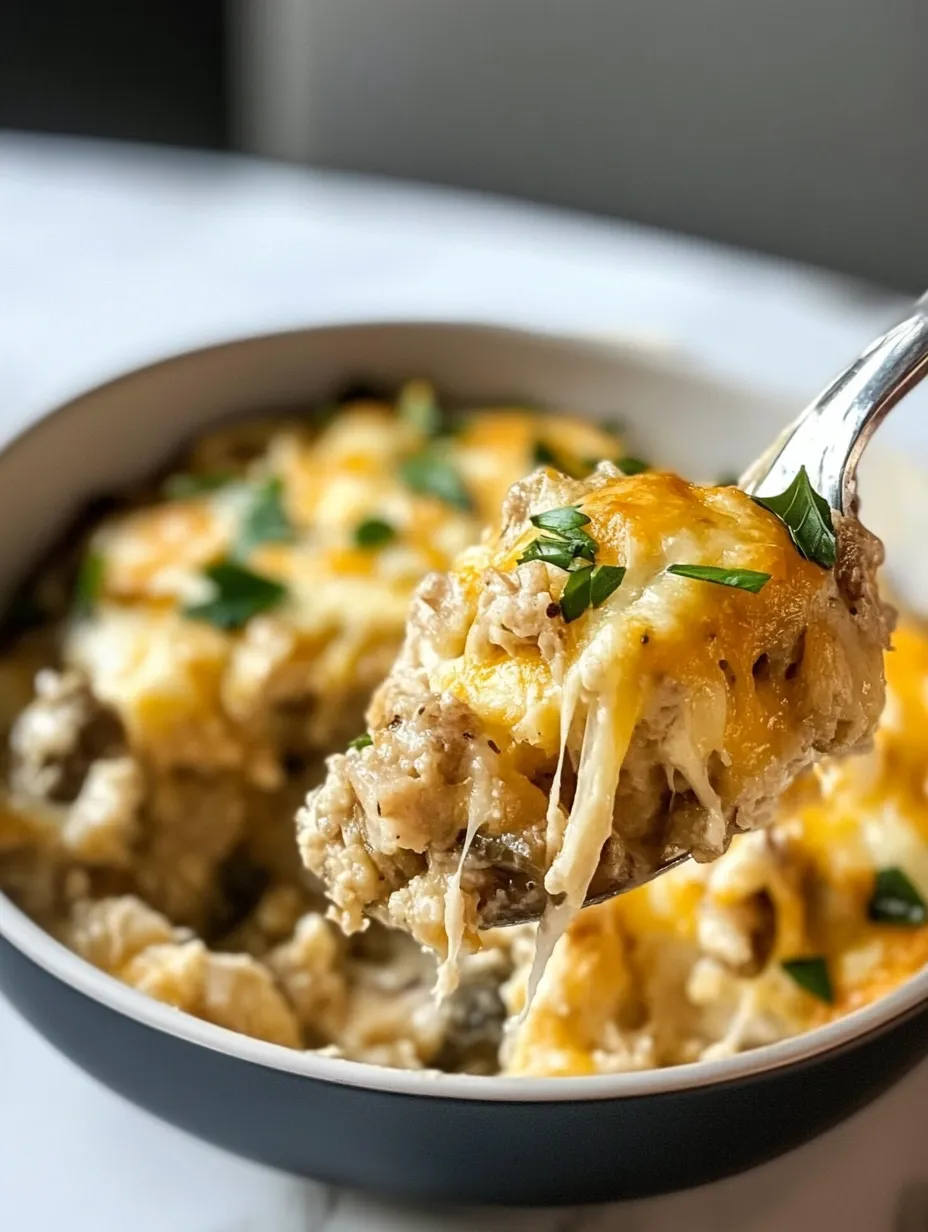Introduction
Thanksgiving is a cherished holiday in which families and friends gather to celebrate and express gratitude for the blessings in their lives. Central to this festive occasion is the traditional turkey feast, often featuring a beautifully roasted turkey adorned with sides of mashed potatoes, green bean casserole, cranberry sauce, and, of course, stuffing. Turkey dishes hold a significant place in Thanksgiving traditions, symbolizing abundance and warmth. Among these delightful dishes, the Turkey & Stuffing Casserole emerges as a comforting, versatile option that captures the essence of the holiday while allowing for a creative twist.
This Turkey & Stuffing Casserole is not just a culinary delight; it’s a testament to the spirit of Thanksgiving, where flavors meld together to create a dish that feels like a warm hug on a chilly autumn day. It’s perfect for holiday gatherings, offering a cozy and hearty meal that can please a crowd. What makes this casserole especially appealing is its quick preparation and ease of cooking. It is an ideal solution for using up leftover turkey, transforming what could be a mundane meal into a scrumptious feast that everyone will look forward to.
In this article, we will explore the ingredients that make this casserole a standout dish, provide a step-by-step guide to preparing it, and share tips to ensure your casserole turns out perfectly every time. Whether you’re a seasoned chef or a kitchen novice, this Turkey & Stuffing Casserole recipe will bring joy to your Thanksgiving table.
Understanding the Ingredients
To create the perfect Turkey & Stuffing Casserole, understanding the key components is essential. Each ingredient plays a critical role in achieving the right balance of flavors and textures, making the dish a true holiday favorite.
Cooked Turkey
Cooked turkey is the star of this casserole, providing both substance and flavor. Not only is turkey a traditional choice for Thanksgiving, but it also offers numerous nutritional benefits. It is a rich source of lean protein, low in fat, and packed with essential vitamins and minerals. After the Thanksgiving feast, many families are left with an abundance of leftover turkey, making this casserole a perfect way to repurpose those delicious scraps. Simply shred or chop the leftover turkey into bite-sized pieces to incorporate it into the dish.
Stuffing
Stuffing is another essential ingredient in this casserole, adding texture and flavor. You can choose between homemade and store-bought options, depending on your preference and time constraints. Homemade stuffing allows for customization, enabling you to incorporate your favorite herbs and spices, whereas store-bought stuffing offers convenience and consistent flavor. Regardless of your choice, stuffing serves as a hearty base that complements the turkey beautifully.
Cream of Mushroom Soup
A key ingredient that enhances the flavor and creaminess of the casserole is cream of mushroom soup. This ingredient acts as a binder, bringing all the elements of the dish together while adding a rich, savory depth. You can opt for a classic canned version or make your own from scratch for a more wholesome touch. The creaminess of the soup helps to create a luscious texture, ensuring that every bite is satisfying.
Mixed Vegetables
Incorporating mixed vegetables into the casserole is not only important for nutrition but also for visual appeal. A variety of colorful vegetables, such as peas, carrots, and corn, can brighten up the dish and add a burst of flavor. Vegetables also contribute essential vitamins and minerals, making the casserole a more balanced meal. You can use fresh, frozen, or canned mixed vegetables, depending on what you have on hand.
Cheddar Cheese
Cheddar cheese adds a layer of richness and flavor to the casserole. It melts beautifully during baking, creating a golden, bubbly top that is irresistible. Different types of cheese can be used depending on your preference; sharp cheddar provides a more robust flavor, while mild cheddar offers a creamier taste. Feel free to mix and match cheeses to create a unique flavor profile that suits your palate.
Discussion on Seasoning
The seasoning of the casserole is vital to achieving a well-rounded flavor. Common seasonings include garlic powder, onion powder, salt, and pepper. Garlic and onion powder add depth and complexity, while salt and pepper enhance the overall taste. You can also experiment with additional herbs like thyme, rosemary, or sage to evoke the classic Thanksgiving flavors that bring warmth and comfort to your meal.
Step-by-Step Preparation Guide
Now that we’ve explored the key ingredients, let’s move on to the preparation of the Turkey & Stuffing Casserole. This step-by-step guide will ensure that you create a delicious, comforting dish that your family will love.
Preheat the Oven
Before diving into the preparation, preheating the oven is essential. Set your oven to 350°F (175°C). Preheating ensures even cooking and helps achieve that perfect golden-brown crust on top of your casserole. A well-heated oven is crucial for casseroles as it allows the flavors to meld together beautifully while creating a satisfying texture.
Preparing the Filling
Once your oven is preheated, it’s time to prepare the filling. In a large mixing bowl, combine the shredded or chopped cooked turkey with the cream of mushroom soup. Stir until the turkey is evenly coated with the soup. This mixture will serve as the heart of your casserole.
Next, add in the mixed vegetables. If using frozen vegetables, there’s no need to thaw them first; they will cook perfectly while baking. Gently fold the vegetables into the turkey and soup mixture, ensuring an even distribution. This will not only enhance the flavor but also add nutritional value to the dish.
Now, it’s time to season the filling. Sprinkle in the garlic powder, onion powder, salt, and pepper. Mix thoroughly to ensure that the spices are evenly incorporated. The seasoning is crucial here, as it will elevate the overall taste of the casserole, making each bite delicious.
Assembling the Casserole
With the filling prepared, it’s time to assemble the casserole. Start by greasing a 9×13-inch baking dish with cooking spray or butter to prevent sticking. Then, spread half of the stuffing evenly across the bottom of the dish. This layer serves as a base for the filling, allowing it to absorb the flavors and moisture during baking.
Once the stuffing is in place, pour the turkey and vegetable mixture over the stuffing. Spread it out evenly to ensure that every bite contains a perfect blend of turkey, vegetables, and seasoning. The next step is to top the filling with the remaining stuffing. This layering technique is important, as it not only adds texture but also ensures that the filling is sealed within the stuffing, preventing it from drying out during baking.
Adding Cheese
To elevate the casserole further, it’s time to add cheese. Sprinkle a generous layer of shredded cheddar cheese on top of the assembled casserole. The cheese will melt and create a delectable, golden crust that is hard to resist. You can use just cheddar or mix in other cheeses such as mozzarella or gouda for added flavor. The combination of cheeses can create a rich and creamy top layer that complements the turkey and stuffing perfectly.
Baking the Casserole
Finally, it’s time to bake the casserole. Cover the baking dish with aluminum foil to trap moisture and prevent the top from browning too quickly. Place the casserole in the preheated oven and bake for 30 minutes. After 30 minutes, remove the foil and bake for an additional 15-20 minutes, or until the cheese is bubbly and golden brown. The total baking time should be around 45-50 minutes, ensuring that the casserole is heated through and all flavors have melded beautifully.
As the casserole bakes, your kitchen will be filled with the mouthwatering aroma of Thanksgiving goodness, making it hard to wait for the final reveal. This Turkey & Stuffing Casserole not only serves as a delicious meal but also creates a warm, inviting atmosphere, perfect for holiday gatherings.
In the next part of this article, we will delve into tips for the best results and explore common questions surrounding this delightful casserole. Stay tuned for more insights to make your Thanksgiving celebration even more special.

Timing and Temperature: Why Covering Initially is Critical
When preparing your Thanksgiving Delight: Turkey & Stuffing Casserole, understanding the role of timing and temperature is essential for achieving the perfect dish. Covering the casserole with aluminum foil during the initial cooking phase is critical for several reasons. First and foremost, it helps retain moisture, ensuring that the turkey remains juicy and the stuffing does not dry out. This moist environment allows the flavors to meld beautifully while preventing the top from browning too quickly.
As a general guideline, cover the casserole for the first 30-40 minutes of baking at 350°F (175°C). This allows the ingredients to cook evenly. After this time, remove the foil to let the casserole develop a delicious golden crust. The final uncovered cooking time typically lasts around 15-20 minutes, allowing for an enticingly crispy topping.
Signs of Doneness: How to Check If the Casserole is Ready
Knowing when your casserole is done is crucial for an enjoyable meal. Look for the following signs to determine doneness:
1. Bubbling Around the Edges: When the casserole is nearly ready, you’ll notice bubbling around the edges, indicating that the filling has heated through and is ready to serve.
2. Golden Brown Top: The top layer should be a beautiful golden brown. If it appears too dark before the casserole is heated through, you may want to cover it again with foil to prevent burning.
3. Internal Temperature: For food safety, the internal temperature of the casserole should reach 165°F (74°C). Use a food thermometer inserted into the center of the casserole to accurately check this.
4. Firmness: The casserole should be firm when lightly pressed in the center. If it feels too squishy, it likely needs more time in the oven.
Cooling and Serving
Once your casserole has reached the desired doneness, it’s essential to let it cool for about 10-15 minutes before serving. This resting period allows the flavors to settle and the casserole to firm up slightly, making it easier to serve. When ready to dish out, use a spatula to scoop portions, ensuring you capture both turkey and stuffing in each helping.
Best Practices for Allowing the Casserole to Set for Optimal Serving
Allowing the casserole to rest is crucial for achieving the best results. Here are some best practices:
– Rest for Flavor: Resting allows the flavors to meld together, enhancing the overall taste of the dish.
– Firmness: Letting the casserole sit helps it hold its shape better, preventing it from becoming mushy when served.
– Serving Temperature: Serving the casserole warm, but not hot, can improve the eating experience.
Suggestions for Garnishing and Presenting the Dish
Presentation can elevate your Thanksgiving Delight: Turkey & Stuffing Casserole. Here are some simple yet effective garnishing tips:
– Fresh Herbs: Sprinkle chopped fresh parsley, thyme, or rosemary on top for a pop of color and freshness.
– Cranberry Sauce: A dollop of cranberry sauce on the side can add a bright, tangy contrast to the savory flavors of the casserole.
– Sliced Green Onions: For a bit of crunch and a hint of spice, consider adding sliced green onions on top just before serving.
Nutritional Information
Understanding the nutritional content of your Thanksgiving Delight: Turkey & Stuffing Casserole can help you make informed choices, especially during the holiday season.
Overview of Nutritional Content Per Serving
A typical serving (approximately 1 cup) contains:
– Calories: 350-400 calories
– Protein: 25-30 grams
– Fat: 15-20 grams
– Carbohydrates: 35-40 grams
– Fiber: 3-5 grams
This casserole is a well-rounded dish that provides a hearty meal, especially when accompanied by additional vegetables or a salad.
Dietary Considerations
– Gluten-Free Alternatives: If you’re catering to gluten-sensitive guests, consider using gluten-free stuffing or bread. There are many brands of gluten-free bread available that can be easily turned into stuffing.
– Low-Fat Options: To reduce the fat content, opt for low-fat versions of cream of mushroom soup and use lean turkey breast instead of dark meat.
Variations and Customizations
One of the great things about the Thanksgiving Delight: Turkey & Stuffing Casserole is its versatility. Here are some suggestions for ingredient substitutions and creative variations:
Different Proteins
– Chicken: If turkey is unavailable or you prefer chicken, feel free to substitute it in equal amounts.
– Vegetarian Alternatives: For a vegetarian version, consider using plant-based protein crumbles or cooked lentils in place of turkey. This option is both hearty and nutritious.
Alternative Vegetables
Incorporate seasonal vegetables to give your casserole a unique taste:
– Seasonal Produce: Consider adding diced butternut squash, sautéed spinach, or sliced mushrooms for extra flavor and nutrients.
– Frozen Vegetables: Frozen peas, corn, or mixed vegetables can also work well and save prep time.
Flavor Variations
– Herbs and Spices: Add depth of flavor by incorporating herbs like sage, thyme, or rosemary. A pinch of nutmeg or black pepper can also elevate the taste.
– Cheese: For a creamy twist, add shredded cheddar or mozzarella cheese in layers to the casserole before baking.
Ideas for Serving Accompaniments
To create a balanced Thanksgiving meal, consider serving your turkey and stuffing casserole with the following accompaniments:
– Roasted Vegetables: Oven-roasted Brussels sprouts or carrots provide a delicious and healthy contrast to the casserole.
– Salad: A fresh green salad with a light vinaigrette can cleanse the palate and add a refreshing touch to the meal.
– Mashed Potatoes or Sweet Potatoes: Classic sides like buttery mashed potatoes or sweet potato mash can complement the casserole beautifully.
Storage and Reheating Tips
After the festivities, you may have leftovers to enjoy. Here’s how to store and reheat your casserole properly:
Best Practices for Storing Leftovers
– Refrigeration: Allow the casserole to cool completely before transferring it to an airtight container. Store it in the refrigerator for up to 3-4 days.
– Freezing: For longer storage, freeze the casserole. Wrap it tightly in plastic wrap and aluminum foil before placing it in a freezer-safe container. It can last up to 2-3 months in the freezer.
Reheating Instructions to Maintain Flavor and Texture
– Oven Method: Preheat the oven to 350°F (175°C). Cover the casserole with foil and heat for about 25-30 minutes, or until heated through. Remove the foil for the last 10 minutes to crisp the top.
– Microwave Method: For quicker reheating, use the microwave. Place a portion in a microwave-safe dish, cover, and heat for 2-3 minutes, stirring halfway through. Be cautious not to overheat, as this can lead to dryness.
Conclusion
The Thanksgiving Delight: Turkey & Stuffing Casserole is a quintessential dish that embodies the heart of the holiday season. It brings family and friends together around the dining table, creating an atmosphere filled with warmth, comfort, and shared memories. Reflecting on the joy of sharing meals, this casserole not only satisfies the appetite but also fosters connections among loved ones.
As you gather around the table this Thanksgiving, consider the significance of each dish served, including the versatile turkey and stuffing casserole. Its rich flavors and hearty ingredients serve as a reminder of the importance of togetherness and gratitude, making your holiday celebration truly special. Embrace the spirit of the season, create new memories, and enjoy the delightful experience of sharing a lovingly prepared meal.


